- News
- Reviews
- Bikes
- Components
- Bar tape & grips
- Bottom brackets
- Brake & gear cables
- Brake & STI levers
- Brake pads & spares
- Brakes
- Cassettes & freewheels
- Chains
- Chainsets & chainrings
- Derailleurs - front
- Derailleurs - rear
- Forks
- Gear levers & shifters
- Groupsets
- Handlebars & extensions
- Headsets
- Hubs
- Inner tubes
- Pedals
- Quick releases & skewers
- Saddles
- Seatposts
- Stems
- Wheels
- Tyres
- Tubeless valves
- Accessories
- Accessories - misc
- Computer mounts
- Bags
- Bar ends
- Bike bags & cases
- Bottle cages
- Bottles
- Cameras
- Car racks
- Child seats
- Computers
- Glasses
- GPS units
- Helmets
- Lights - front
- Lights - rear
- Lights - sets
- Locks
- Mirrors
- Mudguards
- Racks
- Pumps & CO2 inflators
- Puncture kits
- Reflectives
- Smart watches
- Stands and racks
- Trailers
- Clothing
- Health, fitness and nutrition
- Tools and workshop
- Miscellaneous
- Buyers Guides
- Features
- Forum
- Recommends
- Podcast
review
£1,447.00
VERDICT:
Superb gear range and mostly excellent shifting that is very fast and accurate
Good cassette range
Rapid shifting
Lever 3 shifter ergonomics
Lightweight
Shifting when braking not simple
Precise adjustment needed
Chainring size limits lower gearing options
Weight:
2,385g
Contact:
At road.cc every product is thoroughly tested for as long as it takes to get a proper insight into how well it works. Our reviewers are experienced cyclists that we trust to be objective. While we strive to ensure that opinions expressed are backed up by facts, reviews are by their nature an informed opinion, not a definitive verdict. We don't intentionally try to break anything (except locks) but we do try to look for weak points in any design. The overall score is not just an average of the other scores: it reflects both a product's function and value – with value determined by how a product compares with items of similar spec, quality, and price.
What the road.cc scores meanGood scores are more common than bad, because fortunately good products are more common than bad.
- Exceptional
- Excellent
- Very Good
- Good
- Quite good
- Average
- Not so good
- Poor
- Bad
- Appalling
Campagnolo has re-entered the off-road cycling market with Ekar, a 1x gravel-specific groupset that delivers a wide gear range and unique shifter style. It's an excellent mechanical drivetrain option, if not quite perfect, with precise adjustment needed, and a few quirks.
Campagnolo is known as a pioneer within the cycling industry, usually being the first of the three major brands (Campag, Shimano and SRAM) to increase the number of sprockets on the cassette. While Rotor was the first to produce a 13-speed groupset with its Uno, that remains somewhat niche; Ekar is essentially the first 13-speed offering from the three major players, and it's not just a case of adding a sprocket to a drivetrain, but a whole new groupset.
> Find your nearest dealer here
Having given the groupset an initial 'first look', I have endeavoured to test it in typically British weather, helped by our wet autumn, and in an attempt to at least begin to look at durability, amassing just shy of 1,000km in just over a few weeks.
The range
Our complete groupset came fitted to a 3T Exploro, direct from Campagnolo, with a 38-tooth chainring and 9-42T cassette. Currently Campagnolo offers the choice of 38, 40, 42 and 44-tooth chainrings, with three cassette options: 9-36, 9-42 and 10-44.
I think the option fitted will be by far the most popular, as it offers enough bigger gears for faster road riding but still a low enough gear for most. All the options are swayed towards bigger gearing, though, and I think the road 1x market is the main reason: despite being labelled gravel-specific, Ekar could become the first truly viable 1x road groupset.
With a 38-tooth chainring being the smallest available, the only way to achieve a lower gear here would be to switch to the 10-44 cassette. As it stands, does the setup I'm testing create a low enough gear? For me and the riding I do and have done while testing it's been fine, but I know it won't suit everyone – for bikepacking in particular, or certain areas around the country where long, steep climbs are the norm, it might be lacking.
Still, in my opinion it is the best currently available of the mainstream off-the-shelf groupset options – within the gravel sector, a lowest gear of 1:1 is often seen as sufficient, but I believe Ekar offers the best compromise, keeping a low enough gear for climbing while not having to spin too frantically on road sections.
| Cog | 9 | 10 | 11 | 12 | 13 | 14 | 16 | 18 | 21 | 25 | 30 | 36 | 42 |
|---|---|---|---|---|---|---|---|---|---|---|---|---|---|
| Ratio | 4.2 | 3.8 | 3.5 | 3.2 | 2.9 | 2.7 | 2.4 | 2.1 | 1.8 | 1.5 | 1.3 | 1.1 | 0.9 |
| Gear inches | 116.6 | 105.0 | 95.4 | 87.6 | 80.7 | 74.9 | 65.8 | 58.3 | 50.0 | 42.0 | 35.1 | 29.3 | 24.9 |
If Campagnolo doesn't offer a smaller chainring option in the future, chances are third party companies will. For Campag to do so it would need to come up with a design with a smaller bolt circle diameter (BCD) – Ekar has a bespoke BCD of 123mm, and looking at the 38-tooth fitted, clearance for a smaller chainring looks tight if not impossible; perhaps Campag doesn't want to spoil the aesthetics, but to make fitting a smaller chainring possible would require a different chainset.
The cassette
The 9-42 is both two-piece in construction and, you could say, in design: the six smallest sprockets jump up in single-tooth steps, while the differences between the larger seven get increasingly bigger: 9-10-11-12-13-14-16-18-21-25-30-36-42.
This is very different to both Shimano and SRAM arrangements, but I found it key to the groupset suiting the range of riding terrains that gravel bikes allow.
On pure road rides, the gaps between gears are small, with the 9-tooth sprocket there for motoring along when needed. With this particular setup, the 38x9 top gear gives approximately the same ratio as a 46-tooth chainring with 11-tooth sprocket, for reference.
This style of gearing, with the arc across the cassette, is possible because of what Campagnolo calls the 2D Parallelogram. This helps keep the top jockey wheel close to each sprocket, allowing the derailleur to follow a curved path rather than the purely straight path on a standard derailleur, where the only adjustment then would be the b-tension.
The short gaps in the gearing make it a joy both on the road and on faster off-road sections, enabling you to maintain a more constant cadence.
As you start to climb, the change between gears is still reasonably small, with the exception of perhaps the final two sprockets, each having a 6-tooth step, but by the time you are using these the gradient is likely to be pretty steep and cadence less of a concern.
Throughout the hundreds of kilometres of testing, only once did I feel I was 'between' gears and this was on a constant 7% climb that goes on for 4km, where I was pushing hard and jumping between two gears for a fair way. This was between the 14 and 16-tooth sprockets, so not the largest two, but one of the bigger jumps in terms of percentage difference between gears throughout the range. Given the total distance tested, though, to only notice a gap once is quite impressive, I think.
At all other times, either on the road or off, the range and the gears on offer have been great, and one of the real highlights of the groupset.
No doubt some will say the small 9-tooth sprocket is going to increase friction and feel rough when pedalling, but in my experience it feels no different, and certainly not rough or with any noticeable increase in friction.
This isn't a drivetrain designed for time trials, or pro road racing, where tiny percentage differences matter, and for gravel and off-road riding the benefits of being able to have a smaller chainring are far more important. There is the potential downside of the 9-tooth wearing out faster than other sprockets in the cassette, but I can only see it being an issue if you spend a high percentage of your time in that gear – and if you do, maybe you have monster legs and need a bigger chainring.
Shifting performances
The feel of the shifting is very different to both Shimano and SRAM mechanical options, feeling more positive than both. Previously I would never have said Shimano GRX was vague, but after riding with Ekar and periodically riding a GRX-equipped bike in between, that is exactly how I would describe it; there is a less audible click and less feel when shifting between gears.
When set up correctly Ekar shifting is smooth, direct and rapid. Most gear changes are very clean and crisp, although I did occasionally get a rougher one. Initially I put this down to not being used to the throw of the lever, which is different to GRX, but as time progressed I think it is more because of the very precise adjustment needed in the cable tension, and also the pressure used on the lever.
> Your complete guide to Shimano’s GRX gravel groupset
Any occasional poor shifts always seemed to be in the higher gears, 9-14, and as I shifted through to the easier ones things seemed to get smoother, which I wasn't expecting – given the single-tooth gaps between the smaller sprockets you would expect this to be the smoothest area for shifting.
Downshifts are very fast throughout the full range of the cassette, and while previously I would never have considered it a necessity, after returning to other groupsets I really miss the faster action of Ekar. I suspect this is because of a stronger spring within the rear mech or shifter itself, yet the upshifts are also easy and don't require much effort.
While the shifts are mechanically smooth most of the time, they are somewhat louder than Shimano and SRAM, although this is part of the system design and in no way a negative. On the upshifts there is a noticeable audible click from the lever as you pass through each gear change and on downshifts there's both the click of the lever and noise of the gear itself moving. This is something that riders who use a Campagnolo road drivetrain will already be quite familiar with, although I would say it seems louder with Ekar than other Campag groups.
Lever 3
Alongside the range and style of the cassette, the other big plus of the groupset is what Campagnolo has called the 'Lever 3 Design' – a new shape and slightly changed position of the shifter for downshifts. The new position makes it much easier to shift when in the drops than I've found with the road groupset offerings; it is a feature I find very ergonomic and I hope Campagnolo might consider using it for its road groupsets, as for me there is no downside.
The Lever 3 design is also easy to access when on the hoods – I could shift with my thumb without moving my hand off the hoods at all. For the upshifts, this is controlled by the shift lever positioned directly behind the brake lever, with up to three gear changes possible in one throw, although this does then require a large arc. I found single shifts easy, double shifts okay, and rarely attempted to change three gears in a single motion.
As the levers are completely separate for up and down shifts, I didn't experience any accidental shifts at all in use, which is a plus for a groupset designed for rougher riding. The levers are very far apart, making it impossible to accidentally use the wrong one – no accidental downshifts from the hoods when climbing, which is something I have experienced many times with SRAM and its DoubleTap system.
The levers still have a typical Campagnolo look and feel, with a nice rounded design that is really easy to grip and really comfortable to hold, even on longer rides. One very minor point: as the right hand lever does the shifting, it has a few notches under the hoods; these do not impair comfort in any way, but I would like to see them replicated on the opposite lever – they would serve no function, but both levers would then feel identical.
With the rear derailleur is a clutch mechanism which is designed to prevent the cage moving forwards. These have been popular in the mountain bike world on single chainring drivetrains, aimed at preventing the chain from falling off as there is no front mech or chain catcher to help.
In use, the Ekar clutch seems very strong, with almost no chain-slap to be heard even when tackling rough descents. It seems far stronger than the system on either Shimano GRX or SRAM 1x setups. Is there a downside? Shifting is smooth, even to the largest sprockets, so throughout use I would say the impact is all positive.
Braking
The Ekar brakes offer modulation that gives brilliant control, with power there if or when it is needed. From the drops the braking is brilliant, helped by the lever's nice curved shape being easy to reach and pull. There isn't a massive amount of reach adjustment, only around 5mm, but I think it will still suit all riders.
Braking performance from the hoods is also good, although here Shimano GRX has a slight edge. Ekar lacks the broad, flat shape of the GRX levers, and also the slightly grippy textured feel that make GRX levers such a pleasure to use in all weathers. It is by no means poor, but one small area where a minor negative could be given.
As with virtually all disc brakes, they do make a little noise occasionally, almost exclusively in the wet, but they still seem quieter than other brands; it also disappears quickly when the rotors are dry.
Ekar is available with 140mm or 160mm rotors; the test bike had 160mm and they proved enough for all circumstances. The power is there if you need to access it, but easy to modulate and not skid when just looking to slow down gradually.
One bugbear I found was that you cannot shift intuitively when braking; it is possible to shift and brake, but you have to bring the shift lever back away from the brake lever first. When you're in the drops this is fairly easy, though I'd prefer not to have to, but from the hoods I found it a little more tricky just because of the position of the hand.
Campagnolo claims this is done for aesthetic reasons, to ensure there is no gap between the brake and shift levers, so you can't see any light between them. While it might look good, personally I would prefer to be able to shift easily while also braking. Okay, this isn't something that happens that often, but if you know you are approaching a climb immediately following a descent, or approaching a road junction, it can be useful.
Narrow q-factor
The q-factor is the measurement from the very outside of one crank to the outside of the other, taken at the pedal holes.
In general, road bikes will have a narrower q-factor than mountain bikes, which have to be wider to accommodate wider tyres. Within the gravel sector, the q-factor has traditionally been the same as road chainsets, with the exception of GRX, which is 5mm wider.
Does it matter? To some, certainly, and it can be too narrow or too wide. Campagnolo has kept the q-factor low at just 145.5mm, which is identical to its road chainsets. Shimano road chainsets are usually 146mm, while GRX is 151mm.
Wear and durability
Although more time and miles would always be good, at no point in the test period have any issues arisen that would lead me to believe durability will be a major concern. The cassette still looks in very good condition with no wear evident, and the chain is still not stretched. Some will no doubt be quick to judge the chain as being narrower and thus potentially weaker, but in use and through thousands of shifts it has been absolutely fine. The brake pads are also holding up really well, although I am fortunate to ride in an area that isn't too harsh on pad material in general. They're certainly comparable with other makes.
With some really wet and muddy testing conditions through the end of September and into October, Ekar has so far lived up to what the British weather can throw at it.
The one slight caveat is that setup is crucial, and small adjustments can have a big effect. Our test bike came direct from Campagnolo so it was set up perfectly, as you'd expect, but in use I noticed that even very small turns of the barrel adjuster had an effect on shifting; setup and other aspects like mech hanger alignment will be absolutely crucial to ensure clean shifting.
The bottom bracket area has developed a persistent click during use, and while I cannot be one hundred per cent certain, I would put this down to the press-fit bottom bracket. The chainset moves around freely, with no play and no roughness in the bearings, so I don't believe the bottom bracket itself has worn early.
Campagnolo claims that Ekar is the lightest gravel groupset currently available, though it is not something that I have considered while testing. Had the weight come at the expense of durability, that would not be a popular move, but in my experience so far there are no major weaknesses within the system. It has stood up to a fair distance in a short amount of time, over a variety of terrain and in all sorts of conditions.
One for the road?
Given the cassette and chainring options available, there is no doubt in my mind that Ekar has been designed with at least one eye on the road 1x market – as evidenced by 3T making it an option on its Strada 1x specific road bike, although interestingly even this is sold with the 40-tooth chainring and 9-36 cassette.
> How to get ultra-low gearing on your bike
Although only relatively small in overall market terms, Ekar could, I think, potentially deliver a groupset that might finally make 1x road more viable, with range and gearing options to suit. Campagnolo has labelled Ekar a gravel groupset, but the sway towards bigger gearing shows that the road market is clearly an area the company has considered.
Price and conclusion
At £1,447 rrp for the full groupset, Ekar is more expensive than all mechanical Shimano and SRAM gravel groupset options. I think the biggest factor in how successful Ekar will be is how prices of full bikes with Ekar compare to those with other drivetrain options. If prices are at least similar, the performance and, most importantly, the range that Ekar offers will make it a more appealing option.
The price is closer to electronic groupsets from Shimano and SRAM, although even here the style and range of gearing Ekar offers is something neither Shimano nor SRAM can currently match.
Ekar is Campagnolo's first step back to creating off-road groupsets since the early 1990s, and it has delivered an incredible package. It offers excellent performance and will really suit the wide range of riding styles that gravel falls into. There are no major downsides, just a slight reservation with regard to the lack of easier gearing options, which might mean it won't suit all.
Verdict
Superb gear range and mostly excellent shifting that is very fast and accurate
road.cc test report
Make and model: Campagnolo Ekar 13-speed gravel groupset
Size tested: 38T chainring, 9-42T cassette
Tell us what the product is for and who it's aimed at. What do the manufacturers say about it? How does that compare to your own feelings about it?
Campagnolo says, 'Born on Mt Ekar, the 13-speed Campagnolo Ekar is not a conventional groupset. Ekar is the world's lightest gravel groupset: reliable, durable & fast.
'With a wide range, close ratio and no compromise, Ekar is designed from the ground up to give you the very best performance, riding experience and reliability for gravel, all-road and endurance riding on the toughest terrain where you want to face and challenge yourself. From the outset our engineers and design team tested and pursued the route of a 1x system being the best for gravel, and engaged with the challenge of creating the best possible implementation – and the light, efficient, precise 13-speed Ekar is what delivers.
'There is a full range of gearing with smooth, small steps for cadence progression, and a choice of gear ranges to suit the different specialisms within the gravel discipline – each with a wide range, and each with elegantly spaced progressions for smooth changes and no nasty cadence jumps. 1x offers maximum efficiency, no wasted gearing overlaps, an overall light weight system (under 2.4kg) and superior chain retention security. Its gears are designed to be gravel-specific with deliberate and natural-feeling progressive cadence control: 1-tooth steps for small sprockets and bigger steps for larger sprockets – for speeds to match every route.
'Ekar features the best of proven Campagnolo disc brake performance and modulation, and controller technology and feel, all optimised for the very best gravel riding performance. With materials choice to blend the optimum balance of strength, durability and light weight demanded by forward-looking gravel riders, the Ekar groupset offers precise control and reliable performance – Ekar is the world's lightest gravel groupset: reliable, durable & fast.'
Tell us some more about the technical aspects of the product?
Campagnolo lists:
EKAR REAR DERAILLEUR:
New 1x13-specific design
2D parallelogram trajectory for 13 sprockets
Smooth chain running & high security
Locking clutch for easy wheel removal
Carbon fiber-reinforced polyamide & anodised alloys – for light weight, strength & durability
EKAR 13 SPEED SPROCKETS
13-speed
Lightweight, efficient design
Strong, durable construction
Closer high gear spacing
Wider low gear spacing
9-tooth smallest sprocket on two options
New lighter N3W driver standard for wide compatibility
N3W freehub design
EKAR CRANKSET 1X13 SPEED
Lightweight, efficient, secure 1x system
2-piece cranks: steel axle & UD carbon arms
4 ring options: 38T, 40T, 42T, 44T
Easy-change alloy rings – no crank disassembly
4 length options – 165, 170, 172.5, 175mm
Pro-Tech™ Bottom Bracket
EKAR PRO-TECH™ BOTTOM BRACKET
Designed & built specially for gravel
ProTech™ patented sealing system & fiberglass-polyamide tube
Compatible with all current standards
EKAR C13 CHAIN
C13 gravel chain – new for Ekar 1x13
Efficient & secure wide-narrow teeth
Narrow yet incredibly strong
Ultrasound lubrication system
Classic & C-Link™ options
EKAR ERGOPOWER CONTROLS
Comfortable support – Vari-Cushion™
New Lever 3 design for tops-riding
Enhanced grip
Multiple action – Ultra-Shift™ up-shifts
Advanced ergonomics & reach adjustment
EKAR BRAKE CALIPER
Proven high braking performance
Progressive modulation and feel
High performance, long life organic pads
Rate the product for quality of construction:
8/10
Everything appears well made with the quality that people who love Campagnolo have always raved about. Although claimed to be light, this has been achieved without using exotic, lightweight materials such as titanium and masses of carbon fibre. With a full steel cassette, it suggests durability has been a design priority.
Rate the product for performance:
9/10
Extremely good, if not absolutely faultless. The occasional clunky shift and what seems to be requirement for precise adjustment are slight drawbacks but overall still very impressive.
Rate the product for durability:
8/10
No early signs of wear in over 1,000km, which is promising. I had no need to change anything and all features that might wear sooner, such as the chain and brake pads, still look very good with no noticeable wear showing. The chain is showing no stretch.
Rate the product for weight (if applicable)
9/10
Claimed to be the lightest gravel groupset available, which may be important for some. The low weight does not seem to have impacted performance in any way.
Rate the product for comfort (if applicable)
9/10
The Ergopower levers are comfortable, although they did need a slight change in hand position to what I am normally used to, given where the Lever 3 shifter is on the shifter, but it was quick to get used to and overall I liked the shape. I really liked the rounded, narrower shape of the Ergopower lever and it felt better on rougher downhills especially.
Rate the product for value:
5/10
More expensive than other mechanical groupset options such as SRAM Force 1 and Shimano GPX. It does, however, offer something that others don't with the exact style of the cassette as well as the larger range on offer.
Tell us how the product performed overall when used for its designed purpose
I found it excellent; throughout use it delivered a range that suited me and the test riding I did. I do have some reservations about its suitability for some riding styles, especially for those who frequently go bikepacking or tackle steeper off-road climbs, but for general riding it offers performance that should meet almost all riders' needs.
Tell us what you particularly liked about the product
The cassette gearing: close ratio gaps near the larger gears, and well-spaced gears as they increase in size.
Tell us what you particularly disliked about the product
Inability to shift as intuitively as I would have liked when braking. It is possible, but in order to do so you have to move the lever back slightly before being able to shift.
How does the price compare to that of similar products in the market, including ones recently tested on road.cc?
Shimano has three versions of the GRX groupset available: 10-speed RX400, 11-speed mechanical RX600 and the lighter RX800, and RX810 Di2. The RX600 version was tested at £884.93. https://road.cc/content/review/shimano-grx-600-groupset-268195 We tested SRAM Force 1 back in 2016, when it was priced at £1,040. https://road.cc/content/review/194258-sram-force-1
Did you enjoy using the product? Yes, it was excellent.
Would you consider buying the product? Yes
Would you recommend the product to a friend? Yes
Use this box to explain your overall score
Ekar is a groupset that offers a range and style of shifting that genuinely does not currently exist, even using third party parts linked to the main groupset. It really suited the riding that I tested it across, and braking was also very good with fantastic modulation and feel.
About the tester
Age: 35
I usually ride: My best bike is: Cannondale SystemSix
I've been riding for: Over 20 years I ride: Every day I would class myself as: Expert
I regularly do the following types of riding: road racing, cyclo cross, sportives, mtb, Lots of gravel style riding
Matt is an endurance nut who loves big rides and big events. He's a former full-time racer and 24hr event specialist, but now is also happy riding on or off-road and loves long adventures and audax events.
Latest Comments
- kcr 4 sec ago
I think Livingston (no "e") has the best cycling infrastructure I have seen in Scotland. It has an extensive network of paths that are actually...
- kcr 39 min 38 sec ago
I'd say it is an extremely rare condition for most cyclists or runners.
- ErnieC 3 hours 25 min ago
or Team Bahrain ... selective outrage.
- newbankgyratory 4 hours 27 min ago
This website offers suitable data: https://www.automobiledimension.com/large-suv-4x4-cars.php
- newbankgyratory 5 hours 26 sec ago
Perhaps park the goods in a US Customs Bonded warehouse and then import them out of there when the tariff nonsense settles down?...
- Dnnnnnn 2 hours 56 min ago
Good to see a road.cc review of what must be one of the UK's best-selling 'proper' road bikes....
- PRSboy 5 hours 55 min ago
Another thing ruined by the Americans
- Miller 7 hours 14 min ago
Nice to see WvA featuring in the finale.
- Miller 7 hours 17 min ago
I have known more than one elder statesman of the club die of a heart failure while out on a ride. Sometimes I feel that's about to happen to me,...
- Pub bike 7 hours 34 min ago
Via the "wireless active steering system".


























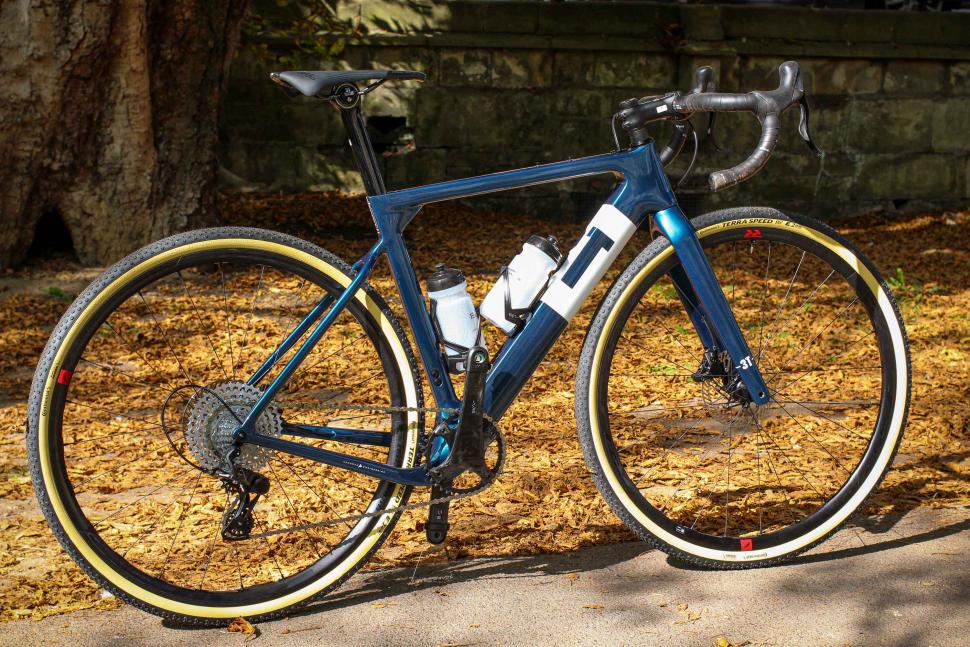


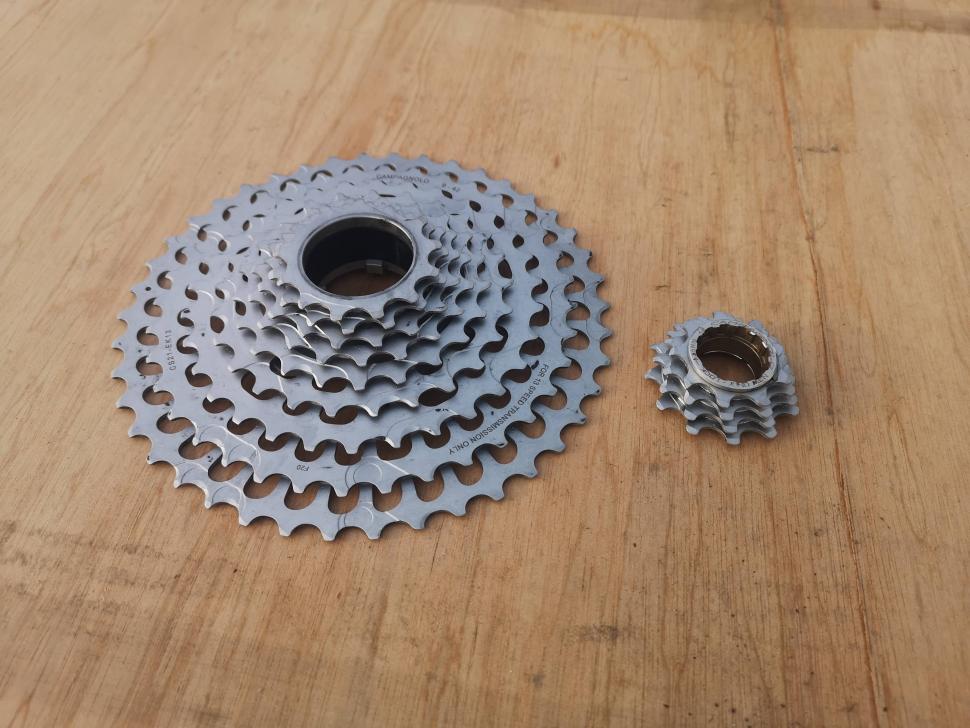


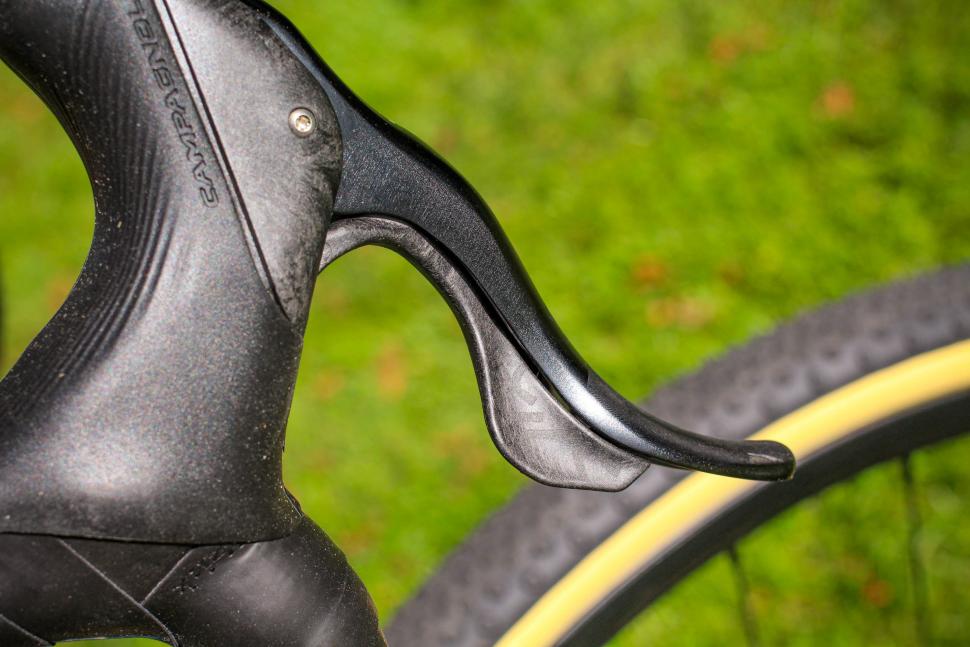
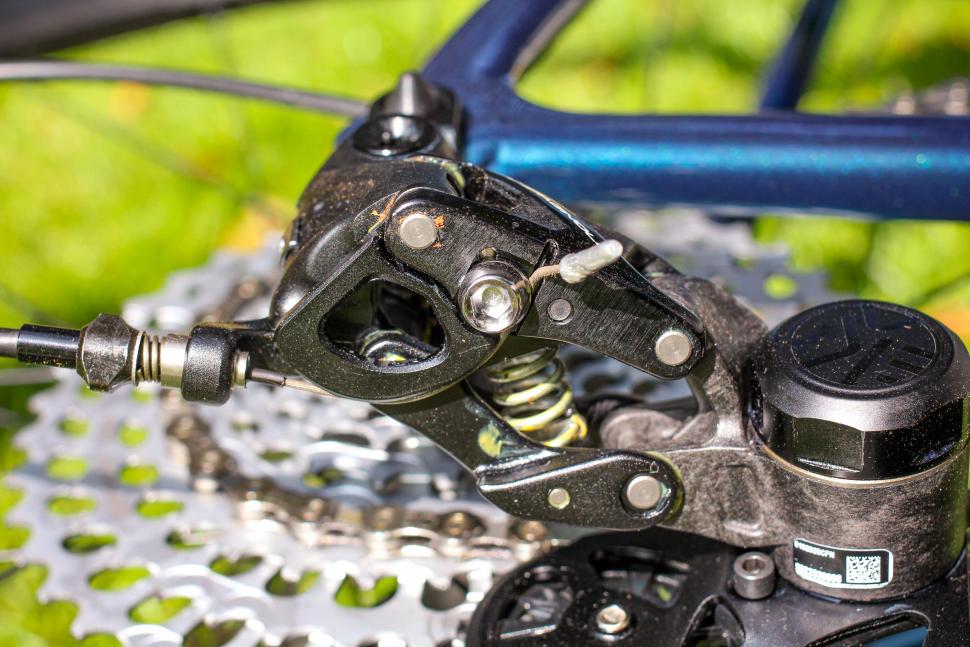

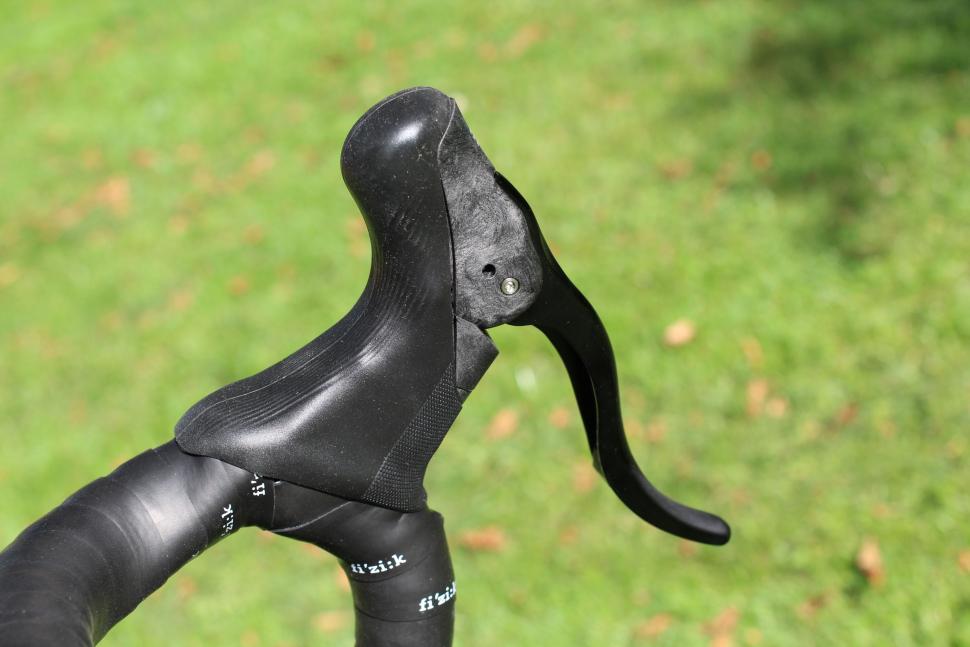
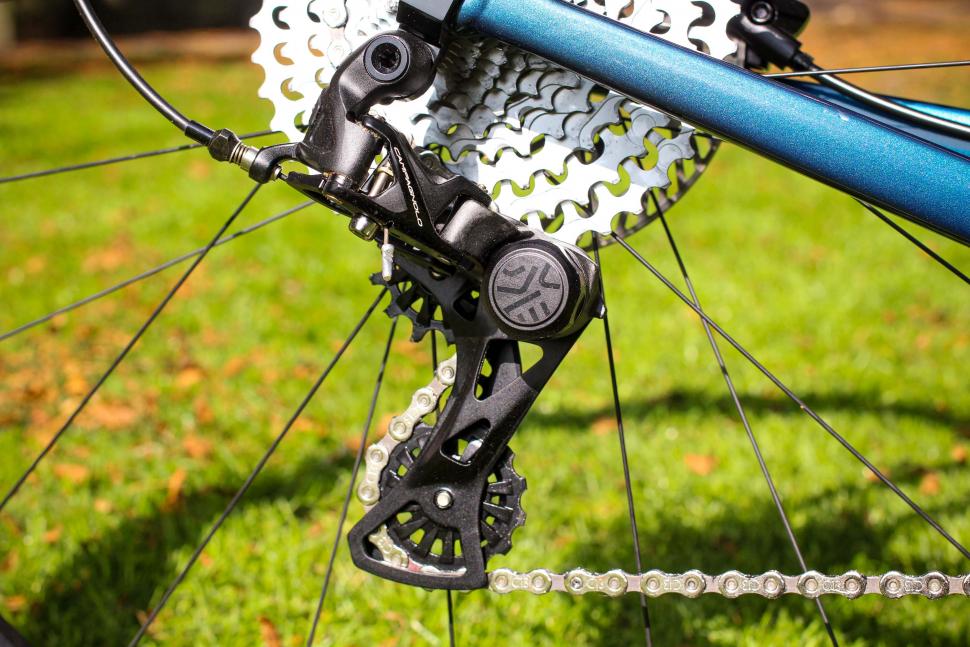
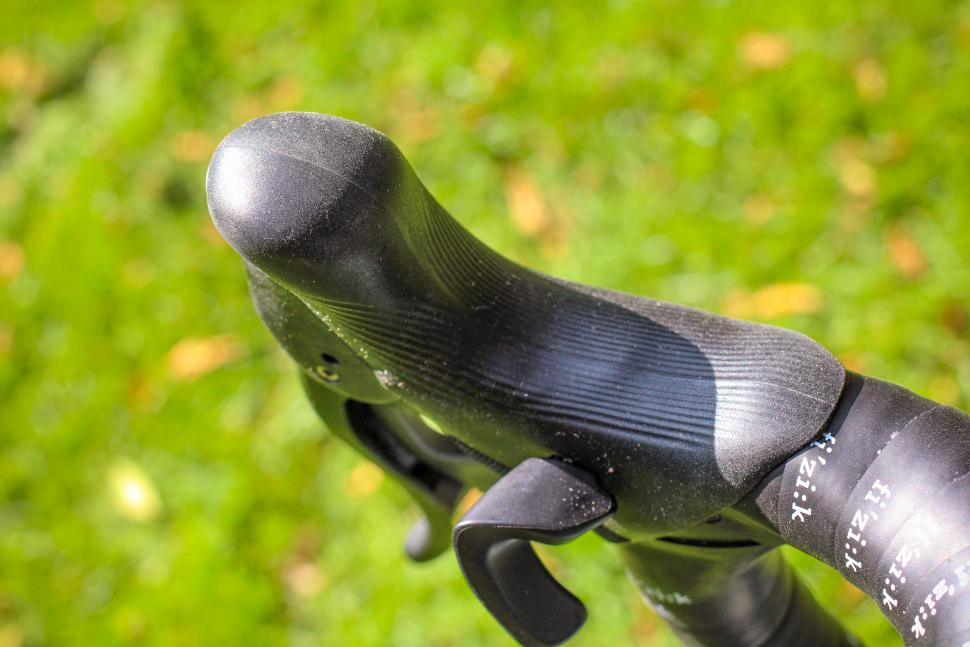
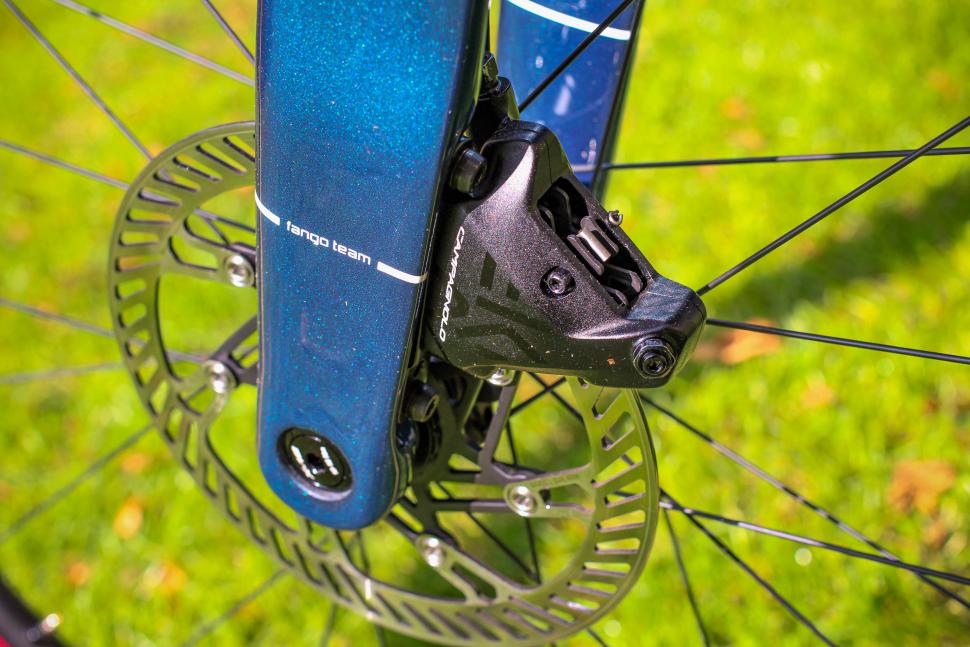
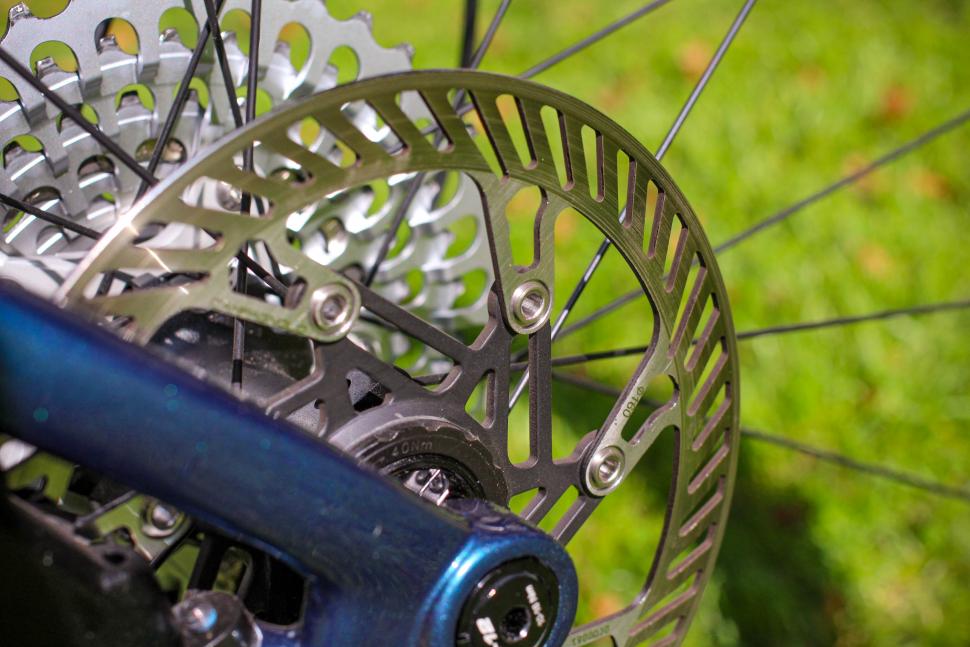
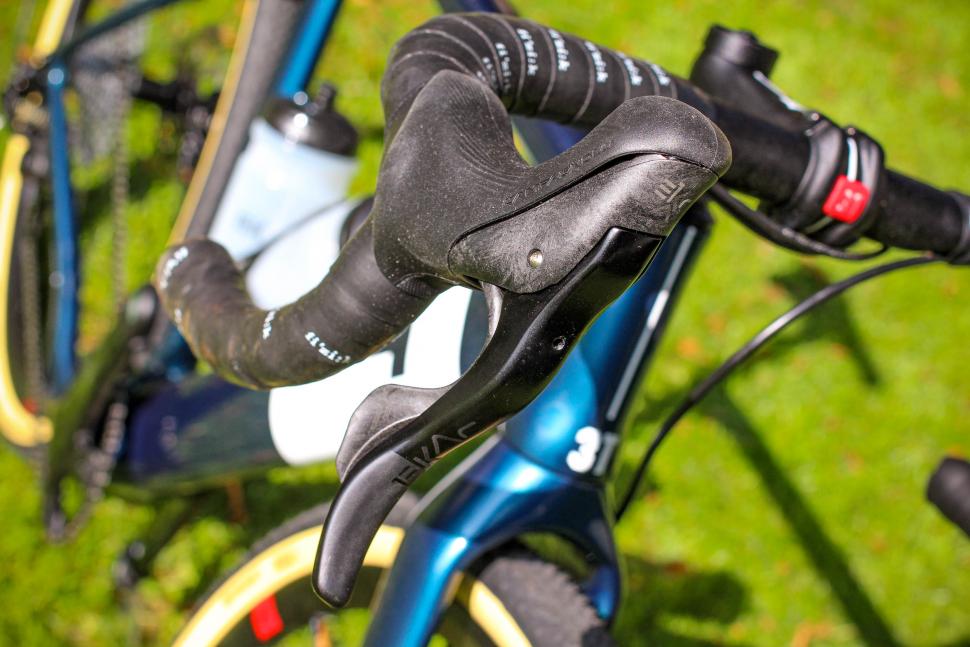


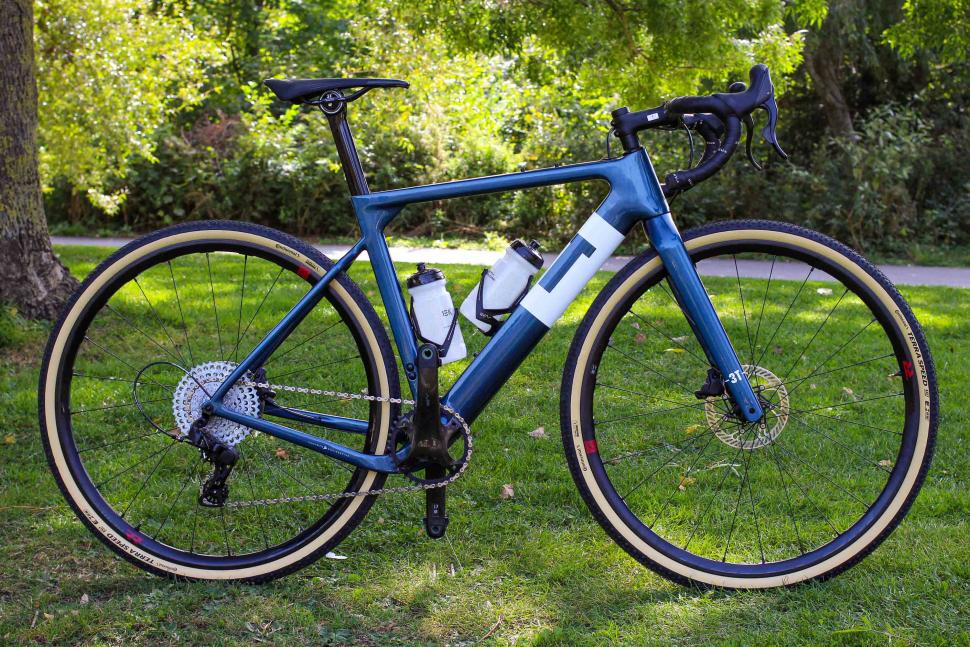



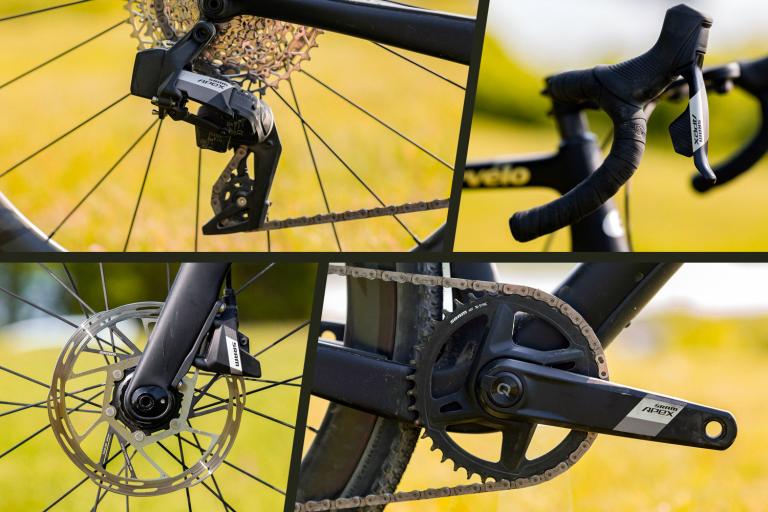
Add new comment
24 comments
I see they're having none of this new-fangled shorter cranks fad
So... Been on Ekar since last November, and here are my long term thoughts.... Much of it negative of I'm honest.
Starting with the good... The groupset looks great, it's lightweight, the gear range is superb and the brakes can work awesomely.
But, a bit like that fit bird you all wanted to date at school, underneath that wonderful exterior there are some real shitty demons just waiting to get ya...
Starting with the brakes... Oh man, when these work well, they are great. However... Don't be so foolish as to turn your bike upside down. Somehow that introduces air into the braking system. Ok, you have to squeeze the brake, but if you do, even once when upside down, you've just commited yourself to a brake bleed. I have become very accustomed to bleeding the ekar brakes.
And... When you wear your pads out, don't for one second think you can put anything in there but campag pads... Other brands campag compatible pads won't work. Suck up that 34 quid a pair cost... Trying anything else is just adding to that cost.
Gears... Man the fucking gears. Look at them funny and they ain't gonna shift properly. I've never had the shifters working well. I've watched every video and dialled everything down to the best of my ability. I still have to accept at least two shit shifts across the block.
Oh, and a nice surprise for ya... The gears need the chain length just right. You can't for instance run two pairs of wheels with different cassette sizes, the chain needs to be spot on length, to within a link. More on that later.
The 9 sprocket is bullshit. Two issues... Ignoring the horrific efficiency issues... 1. You try doing torque efforts in the 9tooth and the chain will slip. Just not enough teeth holding the chain. 2. Descending, be super careful pedalling backwards in the 9 or 10t. Why would you l hear you say... Well, you'd be surprised. Say you are setting up for a corner and you move you legs backwards to get the right leg position... You're pedalling backwards! Anyway, doing this unloads the chain. Got any bump doing this and the chain is off. Basically you will need a chain retention device.
And now to my real beef with the groupset... Running costs and the cost of consumables. I mentioned the punchy brake pad cost, well, that pales into insignificance compared to the cost of the year cable. Remember the shit shifting? Well you'll need to keep you cables running sweet. A replacement ekar cable retails for a staggering £93.99! Mail order you can find it for £55. You'll need to replace this at least once a year.
Chains... They don't last long. I popped a new chain on in June. Done about 1000km since then, mainly dry. Chain is toast. To the point it's taken the chainring with it. That chainring has done probably less than 4000km using two chains. That's now landfill. Just a cool £92 mail order to replace that bad boy.
So here I am, 10months in. This week I've dumped £165 in new parts, and am now looking at another £93.
However, as I'm changing the chainring, I'll take the opportunity to increase the size as the 40t is too small really. But, due to the special links needed to join the chain, I'm realistically going to be binning off the brand new chain to do so. Another £40.
Not exactly an ekar advocate right now.
To summarise. Thinking about Ekar? Unless you love mechanics and have a wallet thats weighing you down, just by GRX.
Thought I'd touch in on this again with an update on my Ekar experiences... and its generally not good.
I'll start with a positive though. I purchased the ludicrously expensive Ekar gear cable, and set it up running outer cable from shifter to mech. Gear shifts are all good now.
Consumables however continue to literally grind my gears.
I've gone through two chains since my last post, from ~2,500km total riding in that period. I've not ridden the bike more than three times between a chain clean throughout that period. On Sunday, I realised that the new chainring fitted in September, is already knackered.
Unimpressed with this lack of durability, I've been exploring why it might be happening. I've identified two likely culprits.
Hands in the air, one of these is potentially my choice in chain lube. I've been using Juice Lubes Viking Lube. Now this lube works best with plenty of 'curing' time, which if you are cleaning your chain every other ride, it hasn't really been getting. I've been cleaning the chain as it needs it, and that's probably down to the lubricants poor performance, sort of a vicious circle thing.
However, I believe that the bigger culprit, and my main reason for this follow up post, is the inherent friction in the drive train. This friction is really noticable, seemingly caused by the rear mech's clutch mechanism. You can tangibly feel resistance ramp up as you move up the cassette onto larger cogs. If you click back down a gear, the friction notably reduces again. Pushing the jockey cage forward after an up shift (obviously in the work stand) also reduce the friction. Where there is friction, there is wear (not to mention inefficiency).
So, I then researched the clutch mechanism to see if there was a way to dial the resistance down, turns out, there is no actual clutch - it's simply a really strong spring! This completely explains the additional friction.
Now what I don't know is whether I have a faulty rear mech (too much friction / tension around the relevant spring), or that all Ekar groups are the same. I'm erring to the side of a poor mech, as whilst I've found other instances online of people complaining about drive train friction, it's by no means a common theme.
Either way, I'm out, Ekar will be coming off my bike.
DECADES AGO...Shimano had a Capreo 9 speed mini groupset (primarily for folding 20" wheeled bikes that featured 9-26 tooth cassette that mounted on a special cassette carrier. The 9 and 10 teeth rings wore out CRAZY FAST AND was perceptibly less efficient unless ones chain was PERFECTLY CLEAN (The acute bend is really bad for chain efficiency). How better to have a larger front ring with a 12 tooth low cassette-oh-new wheelsets wouldn't be "needed" if that was the case.
You can still get Capreo. It's been licensed out to Sunrace. They make a 10sp and 11sp version mainly for the folding bike market as the small wheels make gearing smaller. I never had issues with the 9t wearing when I had it.
I've just pre ordered one of these https://www.orrobikes.com/shop/terra-c-ekar-1x-adventure.
It looks to be excellent value.
It does look to be good value - like many Orro's.
Interestingly the rapid red 3's it's wearing aren't listed as E3W free hub compatible on the Fulcrum site... given they are a Campy subsidiary that's a bit of an oversight.
Reasonable weight for gravel centric wheels at 1760g too.
As for shifting while braking, are you that reliant on the rear brake? The bike has been delivered with the appropriate left-front braking, you can safely shift all the way up and back down the cassette while braking as hard as you like
In the UK we have the front brake on the same side as the shifter.
[/quote]
In the UK we have the front brake on the same side as the shifter.
[/quote]
No "we" don't, it is personal preference, you may have yours set up that way but I have had my front brake on the left since I was old enough to know how to think for myself and how to swap them around.
In the UK we have the front brake on the same side as the shifter.
[/quote]
No "we" don't, it is personal preference, you may have yours set up that way but I have had my front brake on the left since I was old enough to know how to think for myself and how to swap them around.
[/quote]
You might not, but all new bikes leave the shop that way because the law demands it.
The bike pictured appears to be front brake on the left, which is most logical - you can use your most powerful brake to its fullest while also adjusting gears without issue. Just because we ride on the opposite side of the road to most of the world doesn't change that
Shifting while braking isn't really advisable - no matter what type of 'vehicle' you're driving/riding.....
Indeed, I normally stop pedalling when I am braking hard, rather than providing additional forward force when I want to slow down urgently.
If braking in a more controlled gradual manner, then there is no issue about using the same hand.
Prefer to have the most important brake in my dominant hand, I don't understand why people in other countries would want it otherwise.
Looks terrific, so much nicer than SRAM or Shimano offerings, and with the wider gearing maybe even more useful.
IMO the big thing with Campag is the excellent ergonomics - looking at you SRAM AXS on my road bike - I dont have hands like a Lego man, so why have you made the hoods squre blocks!
I'm a diehard Campagnolo user (I've got four at the moment ranging from Athena to SR mechanical and EPS) but I built a Venge this summer with AXS and I have to say I love the shifter shape!
"I hope Campagnolo might consider using it for its road groupsets, as for me there is no downside."
Apart from the obvious one - it's very, very ugly. And aesthetics are normally considered one of the reasons why people like me pay over the odds for a Campagnolo groupset.
FWIW, I've never had any problem with the thumb button push, whether on the hoods or in the drops. And I have small hands.
Nor have I, shifting with the lever is perfect in the drops, fine on the hoods and I can still reach with a little finger on the tops. Honestly don't understand how people have trouble reaching it from anywhere unless they've got some effed up "fit" with the levers pointing at Venus. The bike in the review is a prime example, the bottom of the brake levers are about 3 inches higher than the bottom of the bars. Buy a spirit level folks
That made me smile, it has almost taken the "ugliest thing ever to appear on a bike" award away from the current top end Shimano chainsets.
Where can you purchase a complete groupset in the UK?
A quick search suggests Condor Cycles has stock but the big online retailers don't seem to have it yet.
Bike24 have them...in Germany but still deliver to the UK, normally within 2-3 days
https://www.bike24.com/p2396397.html?menu=1000,4,26
Feels to me that this is designed for Alpine gravel riding where you need that 9T for descending once you're back on paved roads. Stuff like this - https://www.cycling-challenge.com/colle-del-sommeiller/
I think Campy might have a winner here. On price it looks like a competitor to the electronic gruppos' but on function its more comparable to 1x mechanicals which are much cheaper but give away that 2 sprocket advantage as they are both stuck on 11 speed cassettes.
The closest competitor is probably a 1x Mullet AXS build but thats more expensive and a bit of a cludge, to make up for Sram's lack of thought when specc'ing Force Axs - particularly the rear mech range.
It definately has an interesting niche to carve out both for gravel and 1x road. Good luck to them.
For aftermarket attraction the number of wheelset manufacturers who support the new free hub are going to be crucial, otherwise you have to add another £500-£1500 to the price for a Campy compatible set.